#ptolemaic era
Text
I gather there's a kerfuffle over Netflix casting a Black actor as Cleopatra VII. For some m y s t e r i o u s reason I can't reblog my past remarks on this, but in brief, it's not impossible ol' Cleo had a Black ancestor (specifically, we don't know the ethnicity of her paternal grandmother). So a Cleopatra we would label Black is reasonable historical speculation.
13 notes
·
View notes
Note
Dr. Reames, I wanted to ask you, is it known what the Ptolomeos thought of the ancient Egyptian kings?
The Ptolemies gave at least public respect to the traditional gods, following Alexander’s example. It was politic. I don’t know what their private thoughts were, although at least Kleopatra VII (that Cleopatra) presented herself as Isis. I’d suggest chasing down articles by Stan Burstein, who’s one of the leading scholars on the Ptolemies, at least early-on. We also see the emergence of conflated “new” gods such as Serapis. Sorry I can’t be more help.
9 notes
·
View notes
Text
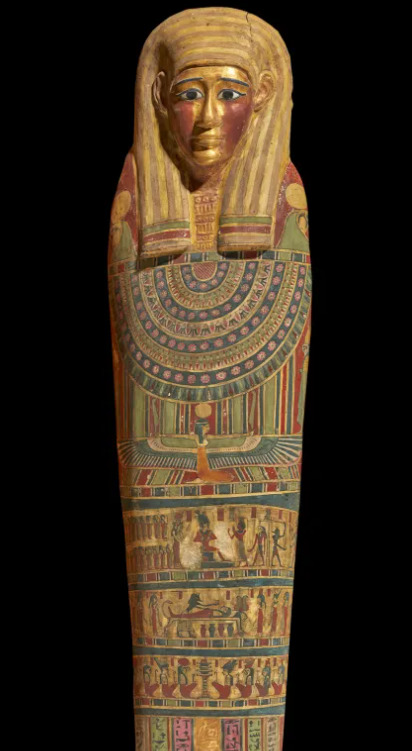
This is really fascinating!! It's amazing what modern technology can tell us about the past!!
#Amulets#Cairo#Egypt#Egyptian Museum#Frontiers in Medicine#Golden Boy Mummy#golden mummy#history#archaeology#ancient history#egypt#egyptian history#arts and culture#mummies#techology#Egypt Independent#mummification#scientific study#Egyptian Ministry of Tourism#Ptolemaic era#CT scan technology#egyptian archaeology#digital scan
2 notes
·
View notes
Text
since I just finished my big sansa embroidery project, I wanted to talk about the process of creating it and my inspiration
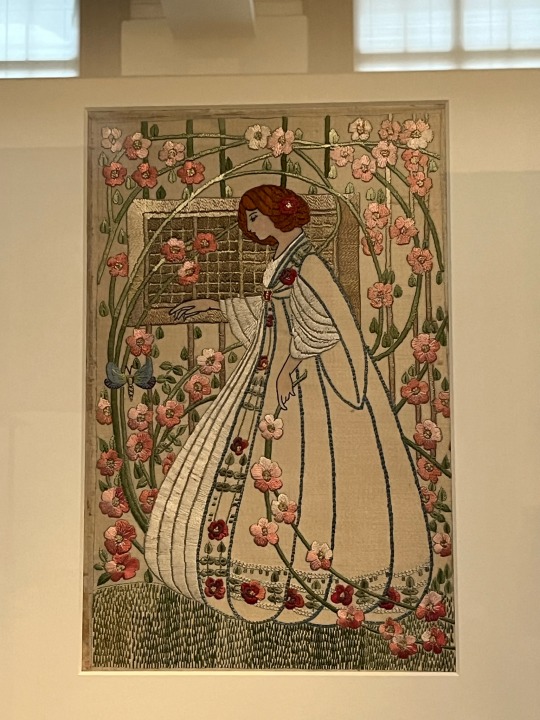
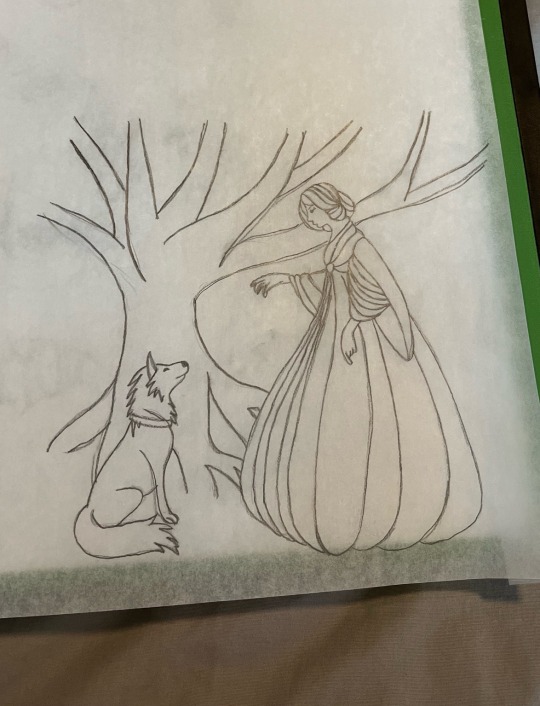
I was inspired by this piece that I stumbled across totally by accident. I was actually researching ptolemaic era egyptian weaving but found this 20th century embroidery and immediately thought of sansa. I created a sketch of sansa and lady in october of 2022 and then traced it on white cotton using a tracing pencil against my window.
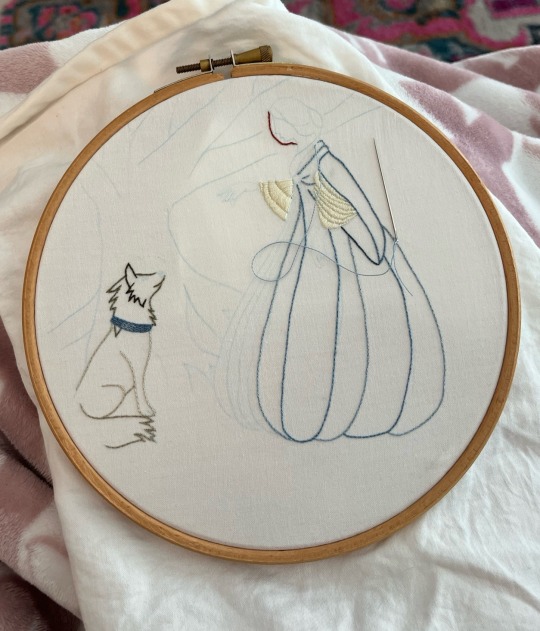

I then began outlining my stitches with a chain stitch using a single strand of embroidery thread. I found that this was really nice for outlining while still blending my colors. For the cream colored thread on sansa’s dress I didn’t outline, which achieved a less blended and more distinct layered effect.
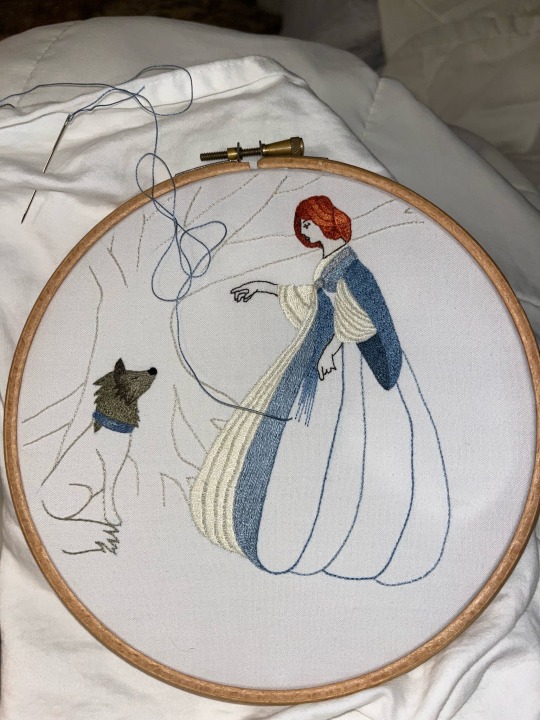

For the majority of the work, I used a technique called needle painting, where the artist uses a series of long and short stitches involving various shades of single strand embroidery thread. This technique was used for the entirety of sansa and lady’s figures.
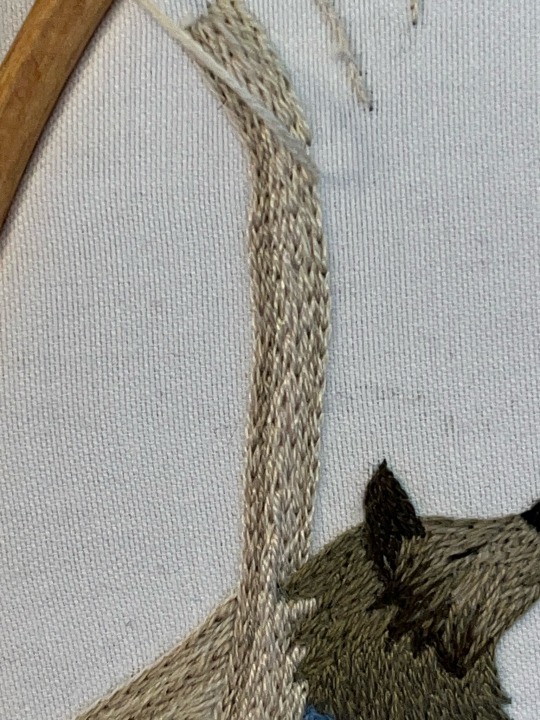
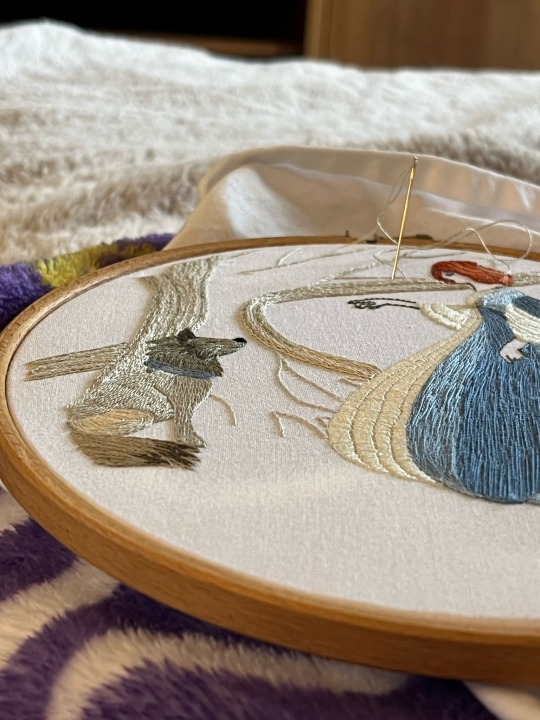
The weirwood tree was a tricky piece for me to work on. Initially I used a technique of horizontal satin stitches to fill in the tree, but ultimately restarted and chose to do vertical chain stitches to imitate real tree bark. I used three shades of tan and cream, using a single strand of the darkest shade, two strands of the medium shade, and three strands of the darkest shade. This created an effect also similar to real tree bark, which I tried to capture in the second picture.
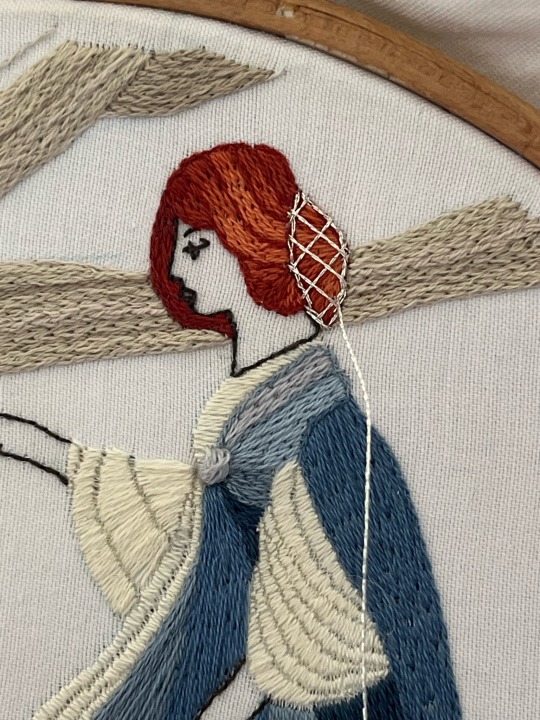

The final touch was adding sansa’s hairnet. I used a metallic silver thread and clear beads, basing it on the amethyst hairnet used to murder joffrey. While the amethysts in the book are black, I used clear beads to match her home of winterfell, where her jewels would match the snowflakes in the godswood.
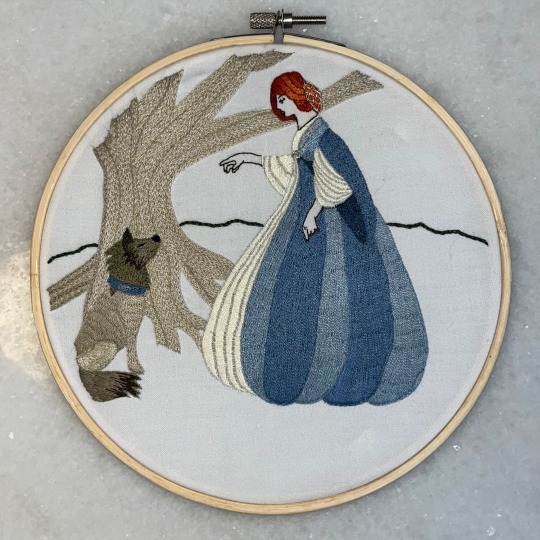
and that's sansa and lady! It may have taken over a year and a half on and off, but I'm super proud and excited about everything new that I learned and improved with embroidery throughout the process. If you have any questions or comments, my asks and messages are always open, I absolutely love talking about embroidery!!
#sansa stark#pro sansa stark#asoiaf#a song of ice and fire#game of thrones#got#lady the direwolf#agot#a game of thrones#valyrianscrolls#long post#embroidery#hand embroidery#art#fanart#sansa fanart#my art#crafts
254 notes
·
View notes
Text
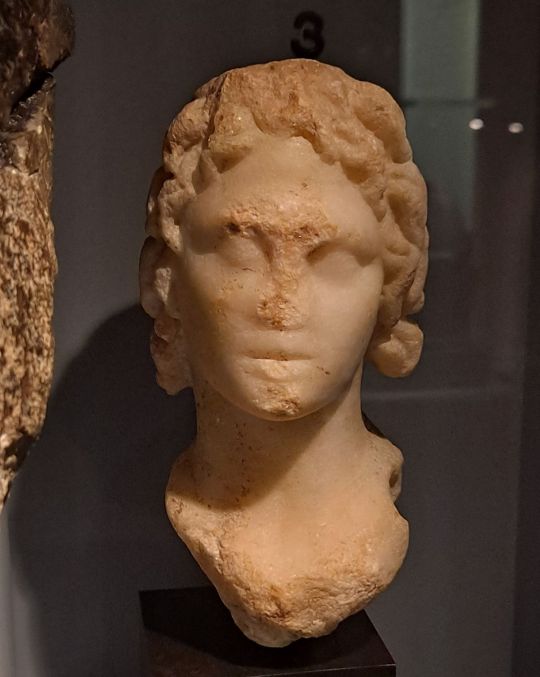
Alexander the Great
* Egypt, Ptolemaic era
* Medelhavsmuseet, Stockholm
Stockholm, November 2023
#Alexander the Great#Ptolemaic Egypt#ancient#art#marble#head#hairstyle#statuette#Medelhavsmuseet#my photo
85 notes
·
View notes
Note
hello! i hope it's alright to ask you this but i was wondering if you have any recommendations for books to read or media in general about the history of judaism and jewish communities in egypt, particularly in ottoman and modern egypt?
have a nice day!
it's fine to ask me this! Unfortunately I have to preface this with a disclaimer that a lot of books on Egyptian Jewish history have a Zionist bias. There are antizionist Egyptian Jews, and at the very least ones who have enough national pride that AFAIK they do not publicly hold Zionist beliefs, like those who spoke in the documentary the Jews of Egypt (avaliable on YouTube for free with English subtitles). Others have an anti Egyptian bias- there is a geopolitical tension with Egypt from Antiquity that unfortunately some Jewish people have carried through history even when it was completely irrelevant, so in trying to research interactions between "ancient" Egyptian Jews and Native Egyptians (from the Ptolemaic era into the proto-Coptic and fully Coptic eras) I've unfortunately come across stuff that for me, as an Egyptian, reads like anti miscegenationist ideology, and it is difficult to tell whether this is a view of history being pushed on the past or not. The phrase "Erev Rav" (meaning mixed multitude), which in part refers to Egyptians who left Egypt with Moses and converted to Judaism, is even used as an insult by some.
Since I mentioned that documentary, I'll start by going over more modern sources. Mapping Jewish San Francisco has a playlist of videos of interviews with Egyptian Jews, including both Karaites and Rabbinic Jews iirc (I reblogged some of these awhile ago in my "actually Egyptian tag" tag). This book, the Dispersion of Egyptian Jewry, is avaliable for free online, it promises to be a more indepth look at Egyptian Jews in the lead up to modern explusion. I have only read a few sections of it, so I cannot give a full judgment on it. There's this video I watched about preserving Karaite historical sites in Egypt that I remember being interesting. "On the Mediterranian and the Nile edited by Harvey E. Goldman and Matthis Lehmann" is a collection of memiors iirc, as is "the Man in the Sharkskin Suit" (which I've started but not completed), both moreso from a Rabbinic perspective. Karaites also have a few websites discussing themselves in their terms, such as this one.
For the pre-modern but post-Islamic era, the Cairo Geniza is a great resource but in my opinion as a hobby researcher, hard to navigate. It is a large cache of documents from a Cairo synagogue mostly from around the Fatimid era. A significant portion of it is digitized and they occasionally crowd source translation help on their Twitter, and a lot of books and papers use it as a primary source. "The Jews in Medieval Egypt, edited by: Miriam Frenkel" is one in my to read pile. "Benjamin H. Hary - Multiglossia in Judeio-Arabic. With an Edition, Translation, and Grammatical Study of the Cairene Purim Scroll" is a paper I've read discussing the Jewish record of the events commemorated by the Cairo Purim, I got it off either Anna's Archive or libgen. "Mamluks of Jewish Origin in the Mamluk Sultanate by Koby Yosef" is a paper in my to read pile. "Jewish pietism of the Sufi type A particular trend of mysticisme in Medieval Egypt by Mireille Loubet" and "Paul B Fenton- Judaism and Sufism" both discuss the medieval Egyptian Jewish pietist movement.
For "ancient" Egyptian Jews, I find the first chapter of "The Story of the Jews: Finding the Words 1000 BC-1492 AD” by Simon Schama, which covers Elephantine, very interesting (it also flies in the face of claims that Jews did not marry Native Egyptians, though it is from centuries before the era researchers often cover). If you'd like to read don't click this link to a Google doc, that would be VERY naughty. There's very little on the Therapeutae, but for the paper theorizing they may have been influenced by Buddhism (possibly making them an example of Judeo-Buddhist syncretism) look here (their Wikipedia page also has some sources that could be interesting but are not specifically about them). "Taylor, Joan E. - Jewish women philosophers of first-century Alexandria: Philo’s Therapeutae reconsidered" is also a to read.
I haven't found much on the temple of Onias/Tell el Yahudia/Leontopolis in depth, but I have the paper "Meron M. Piotrkowski - Priests in Exile: The History of the Temple of Onias and Its Community in the Hellenistic Period" in my to be read pile (which I got off Anna's Archive). I also have some supplemental info from a lecture I attended that I'm willing to privately share.
I also have a document compiling links about the Exodus of Jews from Egypt in the modern era, but I'm cautious about sharing it now because I made it in high school and I've realized it needs better fact checking, because it had some misinfo in it from Zionist publications (specifically about the names of Nazis who fled to Egypt- that did happen, but a bunch of names I saw reported had no evidence of that being the case, and one name was the name of a murdered resistance fighter???)
#cipher talk#I find Leontopolis fascinating because after the first time a bunch of Egyptian Jews built a temple in Egypt a second guy did it#And allegedly had a not terrible scriptural justification! And the temple lasted for THREE EXTRA YEARS after Jerusalem was sacked!#Never let anyone tell you there was only one temple#There's also other stuff but this is what I immediately had#Some books I have I'm pretty sure just aren't good to start with lmao they're about very specific stuff#Modern Middle Eastern Jewish Thought: Writings on Identity politics and culture is interesting and includes Egyptian Jews#But it's definitely got a zionist bias. It's mostly essays#I'd definitely recommend reading up on Joseph Cattaui and Murād Farag because they were simply so influential#Even though Farag was a dumbass that wrote the first Arabic defense of Zionism#Ya‘qub Sannu‘ is also fascinating- he spent a lot of his time defending Muslims to European audiences so some people assumed he reverted#He didn't he just took a hard stance on it. Also he got exiled for criticizing the Khedivate#All 3 are in MMEJT iirc
244 notes
·
View notes
Text

A current illustration that I had for an early celebration of Halloween: Ares dressed up as the famed Roman general, Marcus Antonius, while Aphrodite dressed up as Queen Cleopatra VII Thea Philopathor of Egypt…🎃🍬🍭

I was interested and inspired by the idea that mortals who often dressed as divinities back in ancient times to achieve power, wealth, opulence, and influence, while in this modern-day, divinities often participated in down-to-earth activities, have fun disguising and dressing up as historical mortals for holiday celebrations!!!


Aphrodite’s version of the Egyptian queen was mostly based on the depiction of historically accurate Cleopatra VII made by Joan Francesco Oliveras (@/jfoliveras on Twitter, and Instagram ), as well as statues and statuettes of Isis-Aphrodite that were carved from the Ptolemaic era till the late Roman period of Egypt, albeit taken with modern creative liberties. Isis, during this time, was a very weird figure to say the least, since while still keeping her Egyptian identity and attributes, she was further fused, syncretized, and absorbed the qualities of foreign Greek goddesses like Aphrodite, Demeter, Persephone, Tyche, etc.
With Aphrodite is the fertility goddess of war, love, lust, beauty, passion, and procreation, and later is associated with prosperity, victory, and the ancestral mother of Rome through syncretism with Venus Genetrix; while Isis is the goddess of magic, life, and wisdom, an epitome of eternal maternal devotion, protectress of all living things, from pharaohs to the vulnerable and all aspects of the kingdom, the iconography was adopted by many Ptolemaic queens, particularly Arisnoe II Philadelphos, Berenice II Euergetis and Cleopatra VII.
Ares’ version of Marcus Antonius was based on the historical statue of the Roman politician himself, with his embellishing muscle cuirass based on the Roman Republican statues of Julius Caesar, Augustus (Octavian) of Prima Porta, and Mars Ultor in the Forum of Nevra. With various mistresses (including famous courtesan Cythersis of that time) and marriages to Fadia, Antonia, Fulvia, Octavia the Younger, and Cleopatra VII, their descendants later went to become famous Roman statesmen, or went on to rule the Roman Empire, as well as various clientele kingdoms of modern-day Cimmerian Bosporus, Middle East, North Africa as well. Historically, Marcus Antonius, during his trip to Egypt to visit Cleopatra VII, has always considered himself to be an embodiment of Zeus-Serapis-Dionysus, consort of Isis Aphrodite, but I just think the icon of armed muscular Ares/Mars always suited him more, and look the best.
#ancient greek#ancient egypt#ancient rome#aphrodite#ares#modern day greek mythology#mars#venus#marcus antonius#mark anthony#cleopatra#cleopatra vii#ptolemaic egypt
35 notes
·
View notes
Text
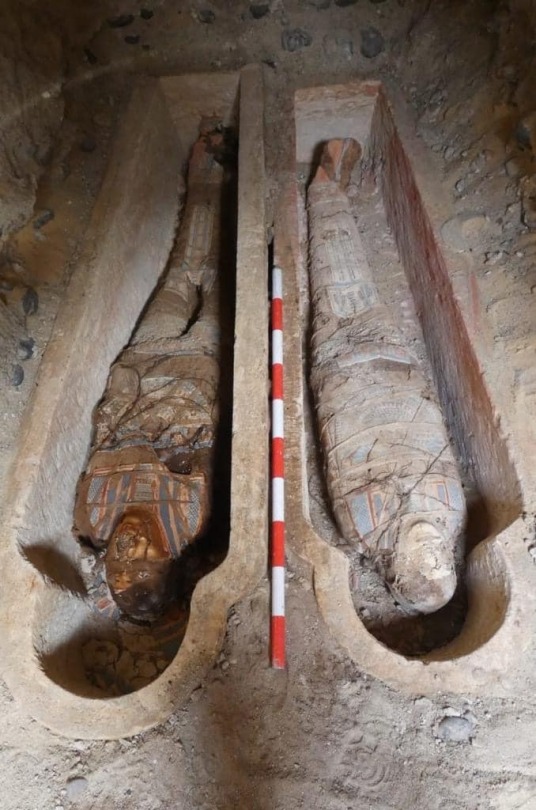
Archaeologists Unearth Mummies with Golden Tongues in Egypt
Archaeologists have unearthed several ancient tombs with dozens of mummies—including some with golden tongues.
Researchers made the findings during excavations at the ancient city of Oxyrhynchus, an extensive archaeological site located around 100 miles south-southwest of Cairo near the modern-day municipality of Al-Bahnasa in Minya Governorate.
Oxyrhynchus was "very important" during ancient Egypt's Greco-Roman period, which spanned hundreds of years from the late fourth century B.C. until the 7th century, Esther Pons Mellado and Maite Mascort, co-directors of a Spanish archaeological mission at the site.
"[It[ was the second city of Egypt after Alexandria. There was a great business and cultural relationship between these two cities," they said.
The Greco-Roman period began with Alexander the Great's conquest of Egypt—then controlled by the Persians—in 332 B.C. An ancient Greek state known as the Ptolemaic Kingdom was subsequently established in 305 B.C., which ruled Egypt until 30 B.C. when the region was conquered by the Romans.


The territory became a province of the Roman Empire, which eventually divided into a western and eastern portion—with Egypt belonging to the latter. The Roman period ended around A.D. 641 when Arab forces conquered Egypt.
The latest excavations at Oxyrhynchus took place in November and December 2023. Over the course of these investigations, Pons Mellado, Mascort and colleagues discovered several tombs from the Greco-Roman era, as well as human remains and artifacts.
The finds include two tombs dating to the Roman period, built with limestone blocks. In these tombs, the archaeologists uncovered more than 20 mummified individuals covered in multi-colored wrappings, as well as papyri with Greek texts and mud seals with Egyptian iconography.
Two of these mummies were found to have pieces of gold shaped into the form of a human tongue placed where their real tongue was. Such golden tongues have previously been found at Oxyrhynchus and, indeed, other archaeological sites in Egypt.
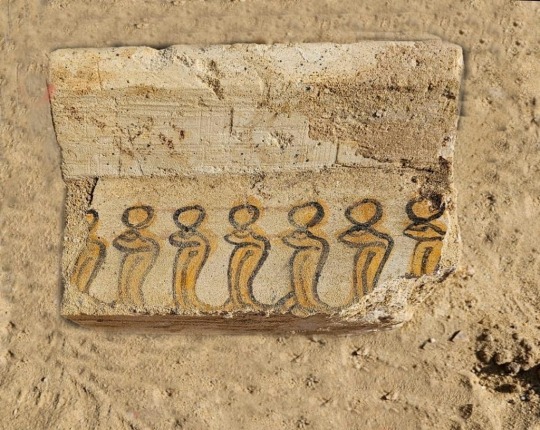
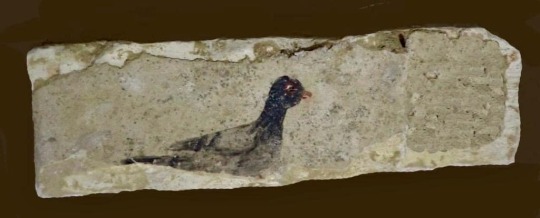
"Until now we have found 16 golden tongues in Oxyrhynchus," Pons Mellado and Mascort said.
Experts think the ancient Egyptians may have placed gold tongues on some human remains to enable the spirits of the deceased to communicate with Osiris—the god of the underworld—and to help them cross into the afterlife.
"The Egyptian people deposited the golden tongues on the tongue to restore vital functions to the dead and also so that the body remained intact in the afterlife. For the Egyptians, gold was the flesh of the gods," Pons Mellado and Mascort said.
In addition to the Roman-era tombs, the archaeologists also discovered three "hypogea"—or underground tombs—dating to the Ptolemaic period that had been excavated beneath the natural rock.
In these hypogea, the researchers uncovered several more mummies covered in colorful wrapping, a number of anthropomorphic stone sarcophagi (some of which were closed) and various terracotta statues depicting the goddess Isis-Aphrodite, among other artifacts. This deity is a form of the Egyptian goddess Isis combined with the fertility aspects associated with the Greco-Roman goddess Aphrodite.
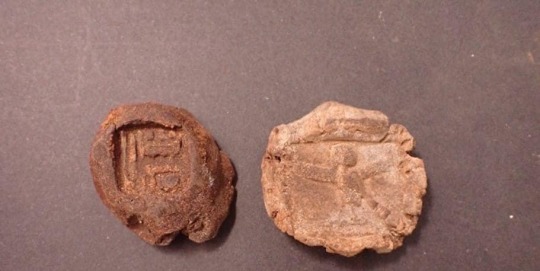

In one of the hypogea, the team also found many multi-colored limestone blocks with decorations, including depictions of humans, snakes, pigeons and plants.
All these findings are very important for the history of the funerary world in Oxyrhynchus," Pons Mellado and Mascort said.
"It is the first time that we have found an Oxyrhynchus terracotta with the image of Isis-Aphrodite, and the first time that this kind of piece has appeared in this area of Middle Egypt. The limestone blocks with decoration [are also very important]."
The limestone blocks—another new finding at Oxyrhynchus—appear to have come from some kind of construction, although the nature of the structure is unclear.
By Aristos Georgiou.


#Archaeologists Unearth Mummies with Golden Tongues in Egypt#ancient city of Oxyrhynchus#Greco-Roman period#ancient graves#ancient tombs#ancient artifacts#archeology#archeolgst#history#history news#ancient history#ancient culture#ancient civilizations#ancient egypt#egyptian history#roman history
81 notes
·
View notes
Text
Guys! I need help from the fandom. I want to draw a series of art with the high lords of all the courts. The task is difficult because there is very little information about them in the text. Here are my suggestions/headcanons:
Spring Court - Because of my headcanons I'm going to have to redesign Tamlin. Britain 17th century, Renaissance, Shakespeare (anyone surprised?)

Summer Court - I thought for a long time, but decided to offer the image of Ptolemaic Kingdom. Closest to the reign of Cleopatra. And a bit of fantasy sea... I think.
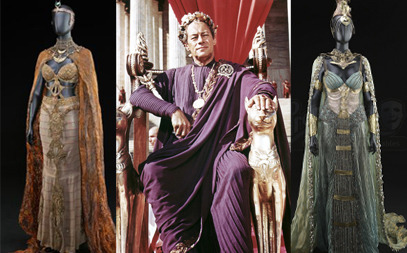
Autumn Court - I wanted to suggest Ireland, but sjm said otherwise. It's not clear from the names, Lucien, Beron, Eris - different names of different cultures. So France of the 15th century. I can't think of a better one.

Winter Court - Norway, vikings. These guys are crazy enough to ride polar bears! Their women are also on equal footing with the men (Vivienne served on the border).

Day Court - Babylonia. Babylonia was conquered by both Persians and Greeks at different times. That's why it suits Hellion. In addition, sciences were widely developed in Babylonia and special attention was paid to magic. Symbolic.
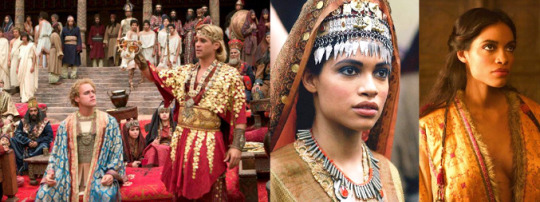
Dawn Court - DAMN IT I WAITED FOR THIS... I mean /clears throat/ the wuxia genre did everything for me. The main thing is to decide on the era. And add a bit of Clockwork City from TESO

Night Court - I don't fucking know (; ̄Д ̄) Seriously, I have no idea. Velaris looks like New York. Hewn City is like a drow city, only with a patriarchy. Illyrian....no comments yet. Can someone tell me how they could come up with such a pile? I need help here, I don't know what to draw
I didn't even try to fit everything into one time frame. It's impossible. But I tried to get into the character of each region.
Please note that the movie stills are just a rough idea of what I want to incorporate into the designs!If anyone has any good ideas, I'd love to hear them! (⌒_⌒)
30 notes
·
View notes
Photo
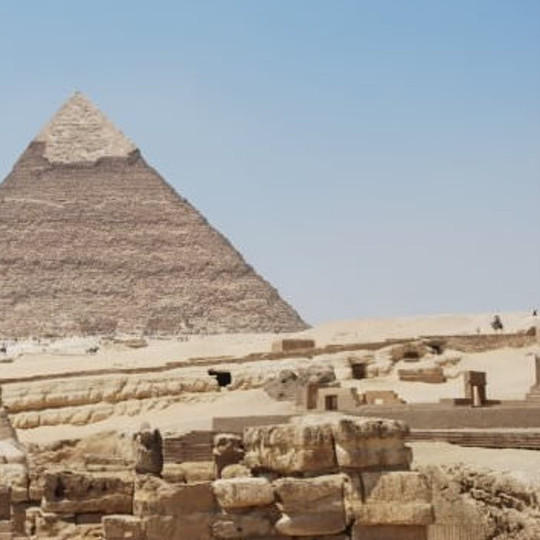
Kingdoms and Periods of Ancient Egypt
The kingdoms and periods of ancient Egypt are modern-day designations for the history of the civilization. The people themselves did not refer to these eras by their modern terms but, instead, dated their history by the reign of a king or a dynasty or event. The modern terms are simply used for ease in studying Egyptian history.
The first Egyptian chronology was created by the Egyptian priest and scribe Manetho in the 3rd century BCE. After hieroglyphics were deciphered in the 19th century, archaeologists then developed his dating system. Scholars proposed different systems for the chronology of ancient Egypt with many agreeing on so-called Middle Chronology. The dates below follow this chronology as proposed by Egyptologist Ian Shaw in 2000, with slight modifications by later scholars. There is no "right chronology" for the Near East (including Egypt) as each dating system provides sound reasons for acceptance.
Predynastic Period in Egypt: c. 6000 to c. 3150 BCE
Early Dynastic Period in Egypt: c. 3150 to c. 2613 BCE
Old Kingdom: c. 2613-2181 BCE
First Intermediate Period: 2181-2040 BCE
Middle Kingdom: 2040-1782 BCE
Second Intermediate Period: c. 1782 to c. 1570 BCE
New Kingdom: c. 1570 to c. 1069 BCE
Third Intermediate Period: c. 1069-525 BCE
Late Period of Ancient Egypt: 525-323 BCE
Ptolemaic Period: 323-30 BCE
A "kingdom" refers to a time of unity and strong central government; a "period" to a time of disunity and decentralized government, with the exception of the Ptolemaic Period. After the fall of the Ptolemaic Dynasty, Egypt was annexed by Rome, entering the period known as Roman Egypt (30 BCE to 646 CE). This period is not always included in lists of Egyptian chronology as it was no longer an independent nation but a province of the Roman Empire until it was taken by the Muslim Arabs in the 7th century.
Continue reading...
33 notes
·
View notes
Text

The statue of Djed-Hor
The statue of the priest "Djed-Hor" is made of black basalt. This statue gained its reputation from the rumors circulating around it that it is under a spell. The statue was found in the Temple of Athibiya in the al-Qalyūbiyya Governorate, in the Eastern Delta and dates back to the Ptolemaic period. It is completely covered in magical texts that were meant to cure the poisonous bites of scorpions and poisonous reptiles. The statue of the priest Djedhor dates back to the Late Era (about 323-317 BC). It bears the artistic qualities of what is known as the "Little Horus Plaques" and is considered one of its varieties. The Little Horus Plaques appeared in the Late Era and were used for therapeutic purposes, especially for treatment of venomous bites. The symbols engraved with these tablets are symbols intended to address another world, the stellar world. In the eyes of the ancient Egyptians, it was a world intertwined with ours; it is the world that souls go to after death and it is also the source from which all things come, and in it lays the causes of all diseases.
The priests of ancient Egypt used to treat the sick by contacting this world. The ancient Egyptian magic is considered a science derived from special sources; the magician uses books on magic spells and recites the charms himself curing the individual's case him. This is known as oral rituals, which were followed by practical rituals.
78 notes
·
View notes
Text
VERY unfortunate that I now have this dog-man character for a campaign (modeled after Anubis), but if I’m not looking at the reference and try to draw him he just looks like some guy’s fursona.
See: With and without ref….


Anyway now that I guess I’m in my anthro era- wassup furry community! I got a lifelong obsession with Spirit: Stallion of the Cimarron and I can’t draw stuff that’s hot, but I can draw semirealistic dog dudes based on the nomadic-group-turned-paramilitary of pre-Ptolemaic Egypt 👍
#it’s making the eyes too big :/#that’s the whole style#it changes it completely lol#anyway bark bork bitches I’m doing self indulgent art again#now that my campaign planning is DONE hehehe#my art#character design#sketches#dogman#he needs to be a creecher#but also a good boy
14 notes
·
View notes
Text
Archaeologists have uncovered dozens of ancient Egyptian tombs and numerous artifacts, including a remarkable set of objects made from gold foil.
An Egyptian archaeological mission coordinated by the Supreme Council of Antiquities unearthed 63 mud-brick tombs and some simple burials at the Tel el-Deir necropolis in New Damietta, a Mediterranean coast city in the country's north.
The tombs are thought to date to ancient Egypt's Late Period, which lasted from 664 to 332 B.C., the country's Ministry of Tourism and Antiquities announced in a statement.
Among these, researchers uncovered a "huge" tomb containing burials of people who appear to have been of high social class. Inside, archaeologists found a collection of gold foil artifacts in a variety of different forms, such as those shaped like religious symbols or figures.
The archaeological mission also uncovered a pottery vessel containing dozens of bronze coins from the later Ptolemaic era during the excavation, as well as a group of local and imported ceramic artifacts. The latter shed light on trade links between the ancient city of Damietta and other settlements along the Mediterranean coast.
The Ptolemaic era began following Alexander the Great's conquest of Egypt—then controlled by the Persians—in 332 B.C. A Hellenistic polity known as the Ptolemaic Kingdom was subsequently established in 305 B.C. and ruled Egypt until 30 B.C., when the region was conquered by the Romans.
Another intriguing find during the excavation in New Damietta was ushabti statuettes, small figurines used in ancient Egyptian funerary practices. They were placed in tombs in the belief that they would act as servants for the deceased in the afterlife.
The layout of the newly discovered tombs at Tel el-Deir has been seen in other ancient Egyptian tombs of the Late Period, the ministry said.
Mohamed Ismail Khaled, secretary-general of the Supreme Council of Antiquities, the latest discoveries at the Tel el-Deir necropolis highlight the fact that ancient Damietta was a center of foreign trade during different historical eras.
Earlier this month, archaeologists announced that a collection of ancient Egyptian artworks and inscriptions had been uncovered hidden below the waters of the Nile.
A joint Egyptian-French archaeological mission identified works in an area of the iconic river, near the city of Aswan, the Ministry of Tourism and Antiquities said in a statement.
The settlement that existed in this location in ancient times was strategically significant, marking the southern frontier of pharaonic Egypt.
13 notes
·
View notes
Text





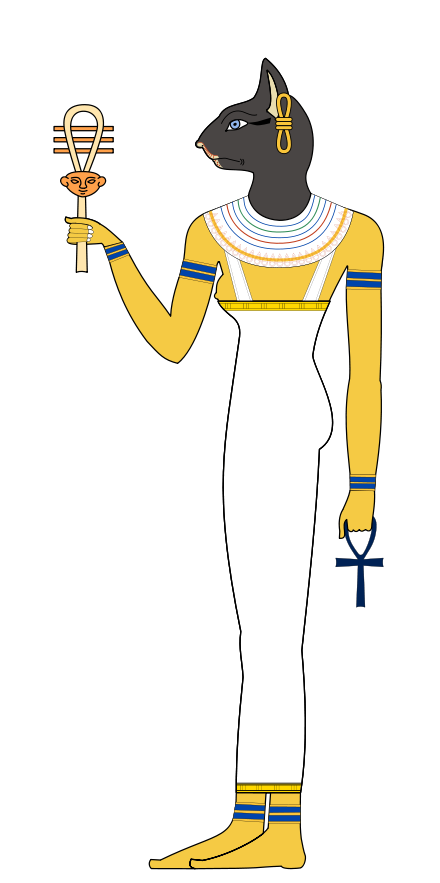
Bastet
Other names:Bast
Major cult center:Bubastis
Symbol:cat, lioness, ointment jar, sistrum, solar disk
Parents:Ra and Isis
Siblings:Horus and Anhur (half-brothers)
Consort:Ptah
Offspring:Maahes
Connection to other gods:Sekhmet, Hathor, Rāt, Tem, Artemis
Celebrations
Bubastis celebrations of Bastet 'Feast of drunkenness'
Bubasteia was celebrated by intoxication,music, debauchery, children would be born without fathers on this day.
Bastet was a goddess of ancient Egyptian religion, worshipped as early as the Second Dynasty (2890 BCE). Her name also is rendered as B'sst, Baast, Ubaste, and Baset. In ancient Greek religion, she was known as Ailuros (Koinē Greek: αἴλουρος "cat").
Bastet was worshipped in Bubastis in Lower Egypt, originally as a lioness goddess, a role shared by other deities such as Sekhmet. Eventually Bastet and Sekhmet were characterized as two aspects of the same goddess, with Sekhmet representing the powerful warrior and protector aspect and Bastet, who increasingly was depicted as a cat, representing a gentler aspect
Role In Ancient Egypt
Bastet was originally a fierce lioness warrior goddess of the sun worshipped throughout most of ancient Egyptian history, but later she became the cat goddess that is familiar today. She then was depicted as the daughter of Ra and Isis, and the consort of Ptah, with whom she had a son Maahes.
As protector of Lower Egypt, she was seen as defender of the king, and consequently of the sun god, Ra. Along with other deities such as Hathor, Sekhmet, and Isis, Bastet was associated with the Eye of Ra.She has been depicted as fighting the serpent named Apep, an enemy of Ra. In addition to her solar connections, sometimes she was called "eye of the moon".
Bastet was also a goddess of pregnancy and childbirth, possibly because of the fertility of the domestic cat.
Images of Bastet were often created from alabaster. The goddess was sometimes depicted holding a ceremonial sistrum in one hand and an aegis in the other—the aegis usually resembling a collar or gorget, embellished with a lioness head.
Bastet was also depicted as the goddess of protection against contagious diseases and malicious spirits.
History
Bastet first appears in the third millennium BCE, where she is depicted as either a fierce lioness or a woman with the head of a lioness.Two thousand years later, during the Third Intermediate Period of Egypt (c. 1070–712 BC), Bastet began to be depicted as a domestic cat or a cat-headed woman.
Scribes of the New Kingdom and later eras began referring to her with an additional feminine suffix, as Bastet. The name change is thought to have been added to emphasize pronunciation of the ending t sound, often left silent.
Cats in ancient Egypt were highly revered, partly due to their ability to combat vermin such as mice, rats (which threatened key food supplies), and snakes—especially cobras. Cats of royalty were, in some instances, known to be dressed in golden jewelry and were allowed to eat from the plates of their owners. Dennis C. Turner and Patrick Bateson estimate that during the Twenty-second Dynasty (c. 945–715 BC), Bastet worship changed from being a lioness deity into being predominantly a major cat deity.Because domestic cats tend to be tender and protective of their offspring, Bastet was also regarded as a good mother and sometimes was depicted with numerous kittens.
The native Egyptian rulers were replaced by Greeks during an occupation of Ancient Egypt in the Ptolemaic Dynasty that lasted almost 300 years. The Greeks sometimes equated Bastet with one of their goddesses, Artemis
Festival
Herodotus also relates that of the many solemn festivals held in Egypt, the most important and most popular one was that celebrated in Bubastis in honor of this goddess.Each year on the day of her festival, the town was said to have attracted some 700,000 visitors, both men and women (but not children), who arrived in numerous crowded ships. The women engaged in music, song, and dance on their way to the place. Great sacrifices were made and prodigious amounts of wine were drunk—more than was the case throughout the year.This accords well with Egyptian sources that prescribe that lioness goddesses are to be appeased with the "feasts of drunkenness".A festival of Bastet was known to be celebrated during the New Kingdom at Bubastis. The block statue from the eighteenth dynasty (c. 1380 BC) of Nefer-ka, the wab-priest of Sekhmet,provides written evidence for this. The inscription suggests that the king, Amenhotep III, was present at the event and had great offerings made to the deity.
──────⊰In Workings⊱──────
*Please know basic protections and energy work before attempting any deity work.*
*It is important to note that everyone's experiences are different and will work with spirits for different reasons. Some people may like a spirit while others will not and that's okay. Ask these spirits what they will work with you on as well as ask them if they can help you with whatever it is you need.*
Ideas for honoring or working with/worshipping Bastet
Altar
Create an altar/sacred space for your rituals and giving offerings for Bastet. Items may include
⬩An altar cloth
⬩Black or yellow candles (you can use any color)
⬩Cup or chalice
⬩Incense and an incense burner
⬩Offering bowl
⬩Statue of Bastet, cat or lion
For more information on basic deity work and altar setups check out the deity work post.
Offering items:Bread, Catnip, Fish, Frankincense, Meats, Myrrh, Perfume bottle, Sistrum, Water
Rituals
⬩Fertility rites and rituals
⬩Protection
⬩Motherhood
⬩You can ask her what she can help you with⬩
𓃠𓃠𓃠𓃠𓃠𓃠𓃠𓃠𓃠𓃠𓃠𓃠𓃠𓃠𓃠𓃠𓃠𓃠𓃠𓃠

For more content relating to other practices/religions or pantheons follow my main blog for updates or ask me anything
If you have any more questions or wish to join a community feel free to join my 18+ discord server
Ask me anything on my blog
#occult#witchcraft#witchblr#deity#neter#neteru#netjer#kemetic#kemetism#Kemetic gods#kemetic pagan#kemetic witch#kemetic paganism#kemetic polytheism#netjeru#spirit#spirits#kemetblr#occultblr#paganism#pagan#witch#Bastet#Bast#neterism
44 notes
·
View notes
Text
youtube
Very much enjoyed this video on the historical reality of the Library of Alexandria. As is probably well known at this point, its reputation was primarily a product of storybooks; there was no Grand Ur-Library that existed for hundreds of years as the premiere collection before being burned down in a fire, resulting in irreplaceable knowledge lost. Instead in the 3rd century BC Alexandria hosted a first-amoung-many-equals library and academic community, before declining in the 2nd century BC as others took its place, and most of its book collection would have long-since decayed by the time the first of its "burnings" under Ceasar would have occurred. It was successful for a brief window, before other cities took the reigns, which was a common back-and-forth of the era.
Something the video only somewhat touches on is that the library itself wasn't really the cause of that 3rd century renaissance; it was the power & support of the ruling Ptolemaic Dynasty of Egypt, which was supporting (financially and culturally) the sciences and arts. Alexandria was the city-to-be-in as a wandering scholar because it was their golden age, the city was rich and peaceful and powerful. If you have that a good library comes as something of a matter of course. And once the dynasty declined and fell into conflict in the 2nd century the funding withered (probably, we have no real sources on library funding), the peace vanished, and thus so did the "Great Library". Which means it was never really about the library to begin with; Alexandra was the thing that was great.
The idea of the Great Library itself is, therefore, really just a way to personify in a single location the idea of the city's heyday, generally after the fact in sources hundreds of years later. At the time it would have just be a piece of the intellectual ecosystem.
25 notes
·
View notes
Text

Egyptian Museum, Turin
Probably from Ptolemaic or Roman era
Turin, June 2023
#figurine#Ptolemaic Egypt#Roman Egypt#ancient#art#hairstyle#Turin Egyptian museum#Italy museums#my photo
175 notes
·
View notes